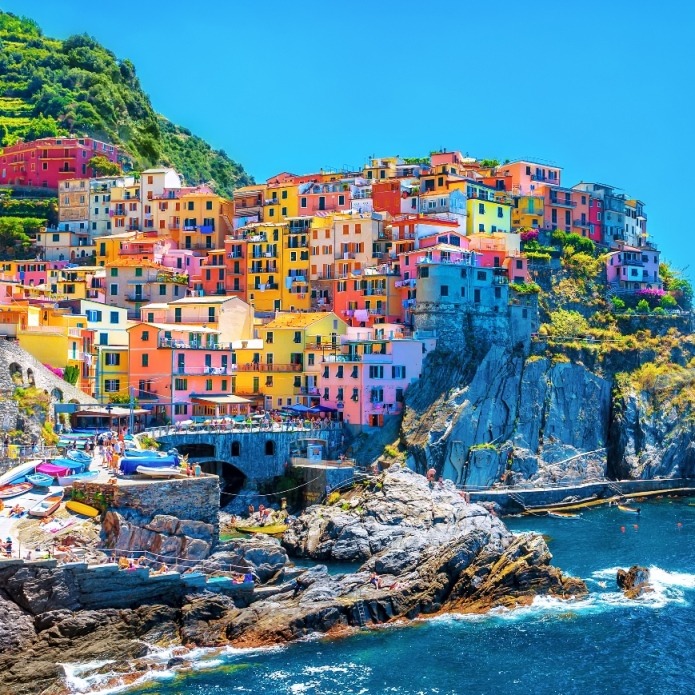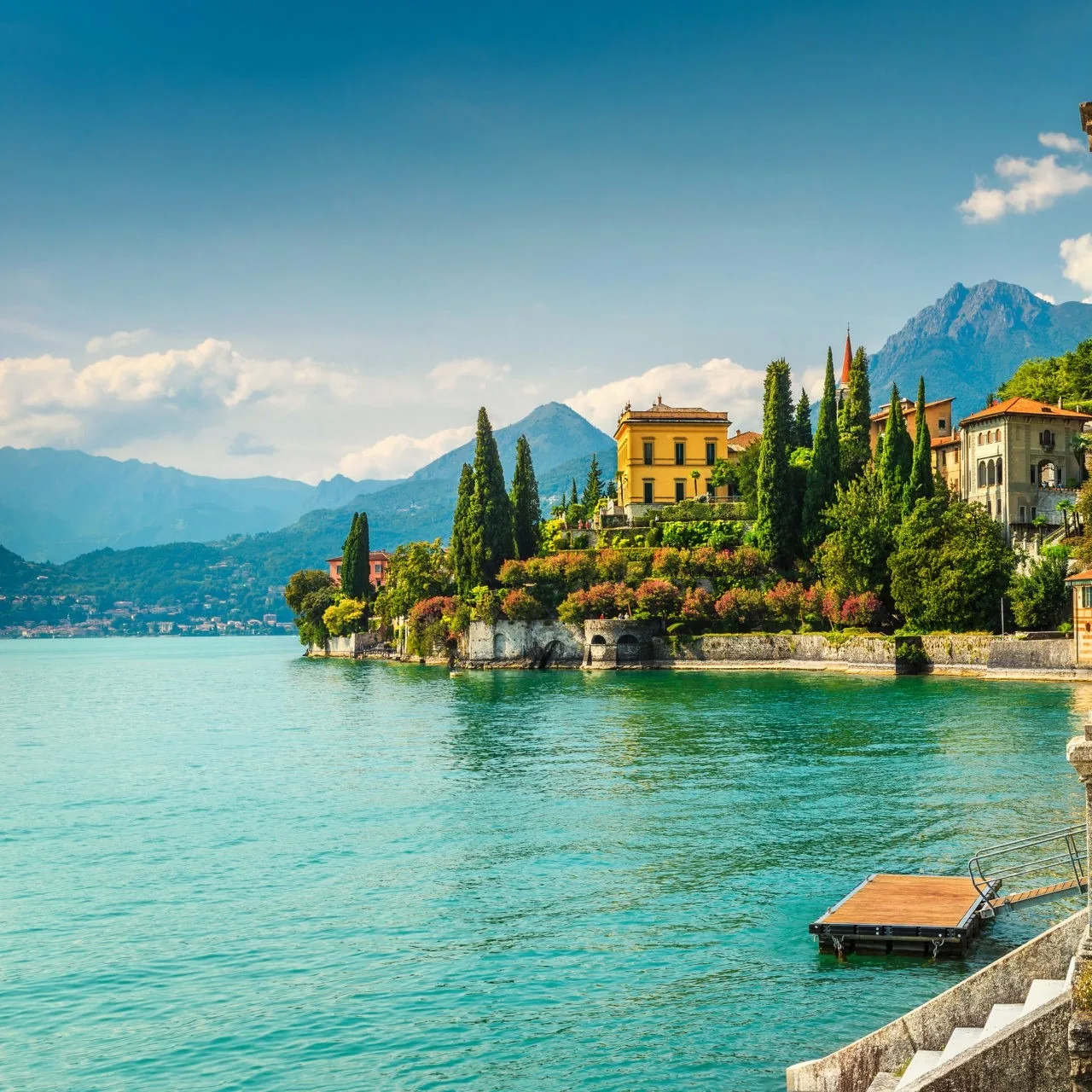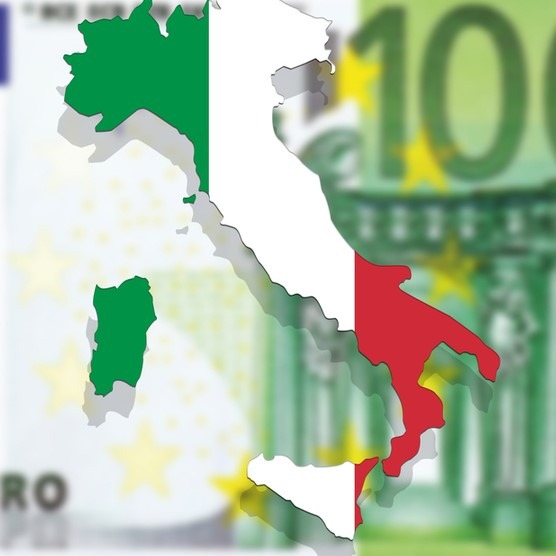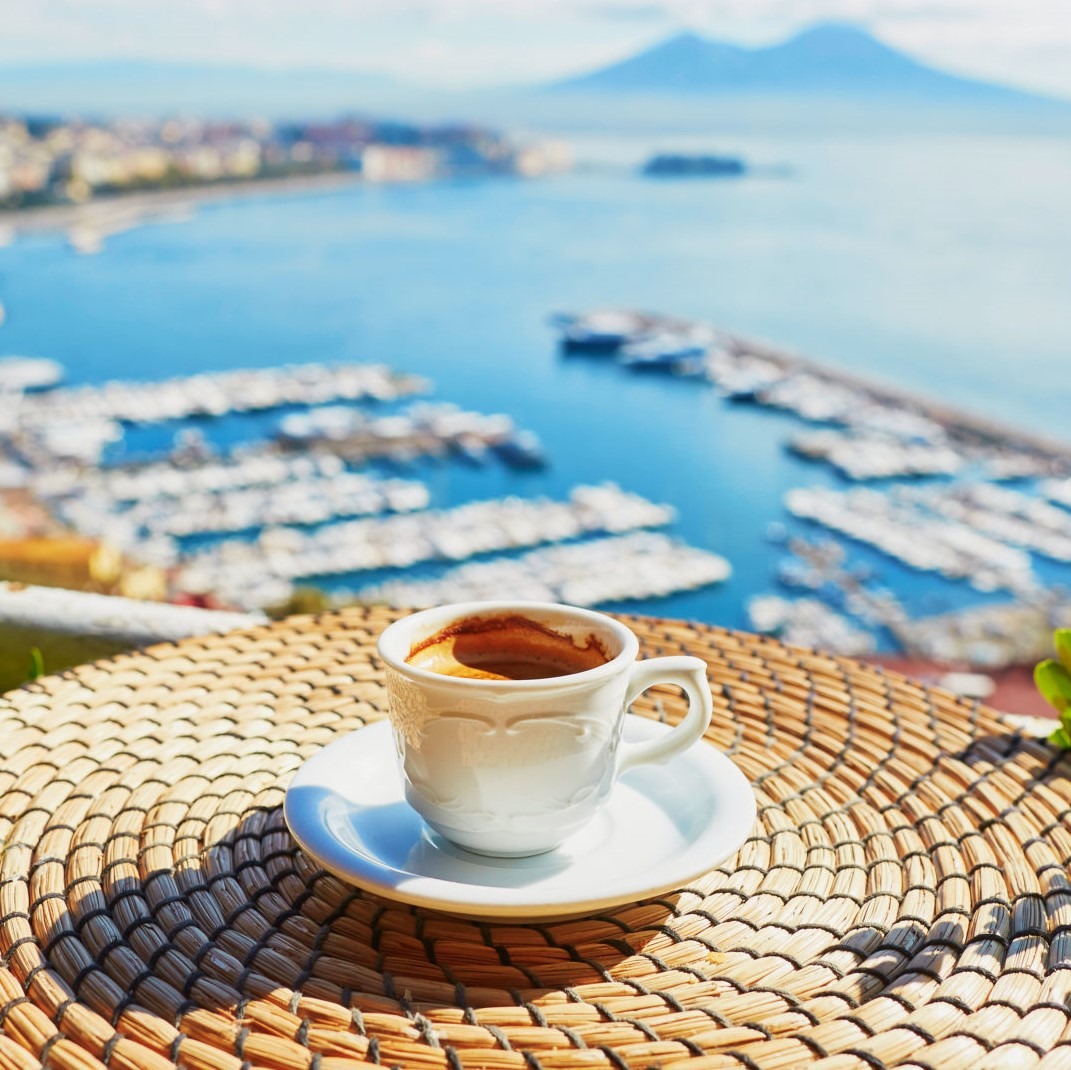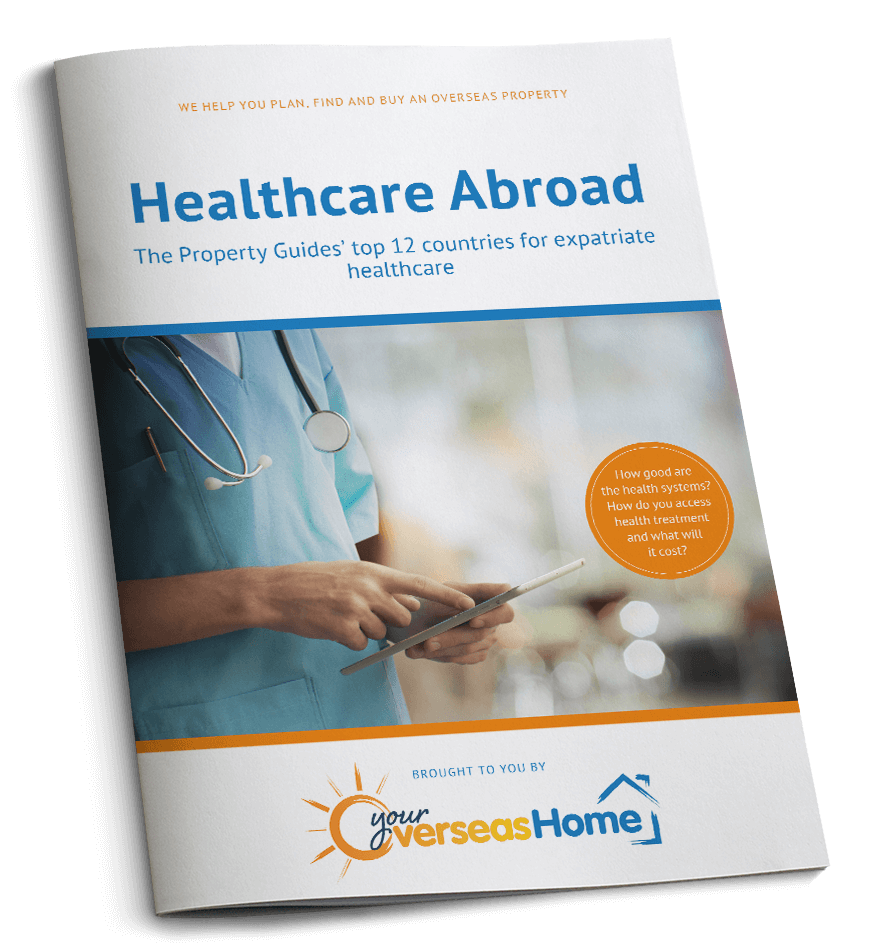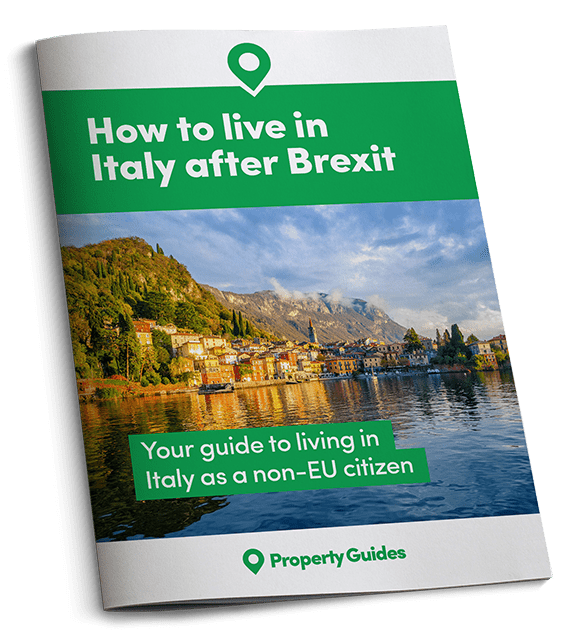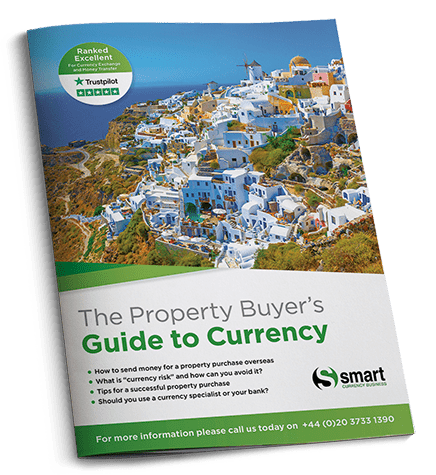Dreaming of a Mediterranean lifestyle? Read our expert advice on moving to Italy, including tips on acquiring a visa and the 90 days rule in Italy, healthcare, finance and finding a home.
Moving to Italy is a popular option for digital nomads, retirees and adventurous people from many countries. It has a generally laidback but fun ambience and work ethic, a low cost of living, fantastic cuisine and rich culture. It’s beautiful all the way from the Lakes in the north to Puglia in the south, and has gorgeous islands such as Sicily, Sardinia and Elba, off the coast of Tuscany.
If you’re dreaming of the Mediterranean lifestyle, maybe with a side order of Renaissance art, ancient architecture and amazing weather, there’s no better place to relocate to. But, before you make the move to Italy from the UK or other third-country nations such as the USA or Canada, there are a few things you’ll need to organise.
From practical steps to legal implications, it’s important that you prepare everything you need before relocating to Italy so that you can start your new life off on the right foot. Plus, if you’re moving to Italy after Brexit as a British citizen you will need the right paperwork. Indeed, even if you are moving to Italy as an EU citizen (Irish, for example) there are still essential processes to follow to ensure you are staying there legally.
To assist you through the process, our comprehensive guide to moving to Italy covers:
- Moving to Italy from the UK after Brexit
- Introduction of the ETIAS for non-EU travellers
- Finding property in Italy
- Financing your move to Italy
- Opening a bank account in Italy
- Claiming your pensions when living in Italy
- Maximising your pension in Italy
- Italy visa requirements
- Italian residency requirements
- Tax planning before you move to Italy
- Types of tax in Italy
- Obtaining your codice fiscal
- The Italian healthcare system
- Where to access healthcare in Italy
- Moving your belongings to Italy
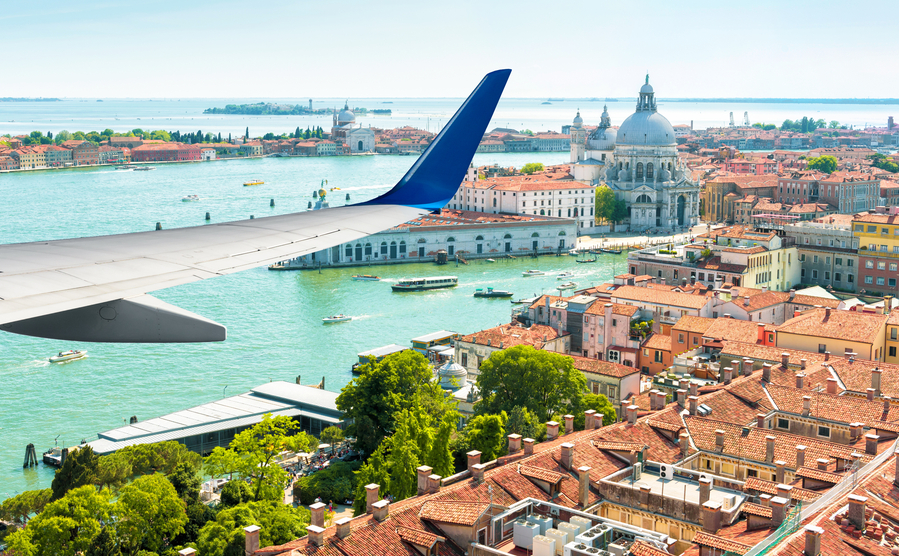
You’re on your way to Italy!
Moving to Italy FAQs
As the UK is no longer part of the European Union, this has changed some rules around living and working in Italy. Luckily, we’ve got the answers to all your most frequently asked questions below. Most of these procedures apply to other ‘third-country nationals’ too.
Can I still move to Italy after Brexit?
The good news is that you can still move to Italy from the UK after Brexit, although the process is now a little more complicated. What you will need to do is apply for a visa. The procedure is not difficult, but it is nevertheless generally advisable to use a lawyer or legal expert. They will find the right visa option for your particular situation.
Can I buy property in Italy?
Italy allows non-EU citizens to buy property there, so Brexit has made no difference, whether you intend to rent it out or live there yourself (permanently or temporarily as a holiday home). This is because property is not covered under the EU’s ‘four freedoms’ — third-country nationals like Australians or Americans have just as much right to buy, so UK citizens do too.
To buy property in Italy start your search on our property portal. Once you find somewhere you love, arrange your currency transfer, go on a viewing trip and then put in an offer on your home.
Can I access Italian healthcare after Brexit?
Non-Italian citizens can access state healthcare, but there is usually at least an element of insurance required too. If you’re paying into the Italian social security system, then you’ll receive state healthcare in the same way as an Italian national. If you plan to live in Italy permanently, you should register with the Italian healthcare system. If you were living in Italy before the 1st of January 2021, then you’ll maintain your pre-Brexit rights to healthcare.
If you’re visiting temporarily (for example when viewing property) as a UK citizen you should register and take your Global Health Insurance Card (GHIC). This is the replacement for the EHIC and will give you access to emergency healthcare while visiting Italy. However, it is still advisable to take out travel health insurance too as the GHIC does not cover everything.
Healthcare for retirees after Brexit
The agreement that the UK has made with the EU for reciprocal healthcare means things continue pretty much as they were before for retirees moving to Italy. If you receive a UK State Pension, all you need to do is apply for an S1 form and you can access free healthcare on the same basis as an Italian citizen. And it gets even better — your S1 form can also include dependents, such as a spouse, a civil partner and children under 26.
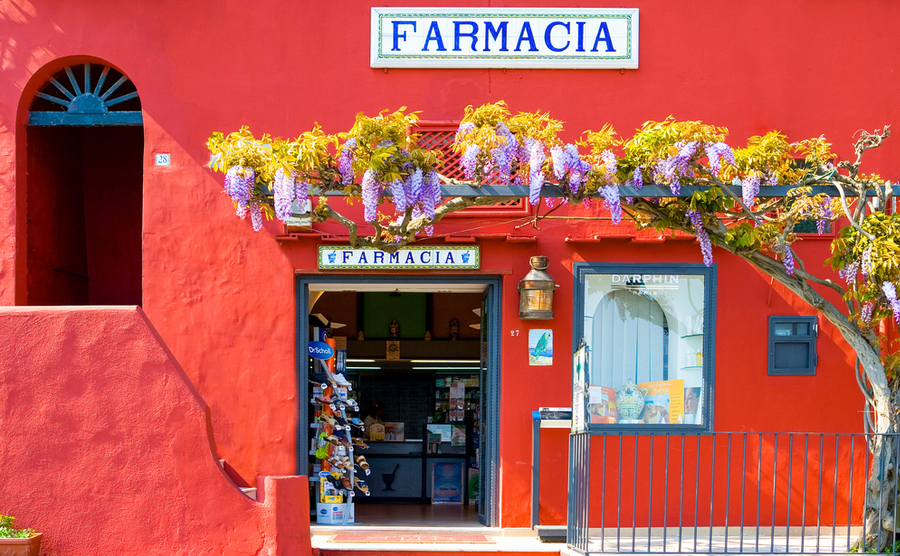
Your local pharmacy, if you move to Capri… (Gimas / Shutterstock.com)
Do remember that although many things will be free in Italy, the list may not be exactly the same as in the UK on the NHS. You will receive emergency care, hospital admissions, and GP appointments for free, but things like specialist referrals, diagnostic tests, and prescriptions will need to be paid for via a co-payment known as a ‘ticket’. You can find out more about this in our healthcare section below.
How do Italian visas work?
Most international citizens, including UK and North American, don’t need to apply for an Italian visa if they’ll be residing in the country for up to 90 days within a 180-day period. If you’ll be in Italy for more than 90 days, then you need to apply for a visa.
The Italian Ministry of Foreign Affairs (MAECI) is also referred to as the Farnesina, after the name of its headquarters in Palazzo della Farnesina in Rome. Their website has a useful section, in five languages, relating to visas for Italy (Il visto per l’Italia). You simply answer four questions:
- your nationality,
- country of residence,
- requested length of stay (up to 90 days or more than 90 days), and
- a “reason for stay”. These are available in a drop-down list and include elective residence, salaried employment, self-employment, and study.
You are then given basic information on what is required to make a visa application, and where to apply.
Can British people work in Italy after Brexit?
The days of being able to go to Italy and find work are largely over for British people, just like other non-EU citizens. Those who are offered a job by an Italian company may be able to work in Italy, but the government runs a complicated ‘flow’ system of work permits, so it is worth speaking to a lawyer about how to get one.
If you were living in Italy and registered before the 1st January 2021, then you have the right to work in Italy as you were before Brexit.
Can I receive my pension in Italy after Brexit?
When you retire to Italy you can still claim your UK state pension. You will need to tell the UK government offices that deal with your benefits, pension, and tax that you are moving or retiring abroad. You can read more information on this in our pensions section below.
Can I drive in Italy after Brexit?
You can drive in Italy as a visitor as long as you carry your UK driving licence with you. While there was some speculation around International Driving Permits (IDPs), the latest government guidance states that you do not need an IDP to visit and drive in the EU. If you have a paper driving licence or a licence that was issued in Gibraltar, Guernsey, Jersey, or the Isle of Man, then you will need an IDP to drive in Italy.
If you’ll be living in Italy, then you’ll need to transfer your UK driving licence to an Italian licence.
Introduction of ETIAS for non-EU travellers
From the end of 2022, travellers from the UK to Italy will be required to complete a European Travel Information and Authorization System (ETIAS) visa. This will become a requirement for all visitors entering the Schengen Area from a non-Schengen member country for up to 90 days in any 180-day period. If you’ll be visiting Italy temporarily before your move, such as for a property viewing trip, then you may need to bear this in mind.
The ETIAS is intended as a security screening measure. Everyone will be required to complete an ETIAS form, which will ask for basic information including full name, date of birth, passport details, and travel plans. You may also be asked some health and security questions.
You will need to pay a small fee of around £6 for each form, but once completed the ETIAS will be valid for three years. Travellers under the age of 18 or over the age of 70 can apply for their ETIAS free of charge.
Finding property in Italy
Our comprehensive guide to buying property in Italy will take you through the process of finding a property, hiring a legal team and making an offer.
There are several contacts you should have when moving to Italy from the UK. As a minimum they will an estate agent, a currency specialist and an English-speaking lawyer to help you navigate the process.
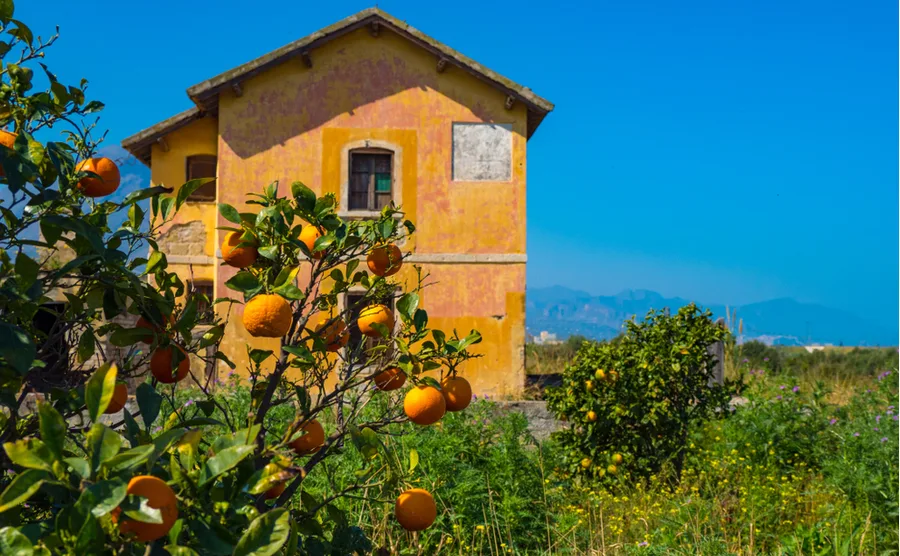
Moving to Italy offers a range of beautiful and affordable homes
Once you have your team, you can then start the exciting part: your property search. Italy Property Guides have helped thousands of people find their dream home abroad, and we can show you fantastic properties for sale in Italy, including houses, villas, apartments. What’s more, we cover all the latest Italian property news, including market forecasts, laws and regulations, and our tips for choosing the perfect location to help you get the most from your purchase. Don’t forget to download our guide to planning a viewing trip too so you can prepare for this crucial step.
Financing your move to Italy
Moving abroad is a big financial decision requiring careful planning. Key things to consider include:
- How you will fund your property purchase
- Your maximum buying price, bearing in mind buying costs
- The cost of living in Italy
- The cost of ongoing maintenance for your property
- How your pension and tax liabilities will be affected by your purchase
- How you will make payments to Italy
Italy Property Guides have a wealth of information to help you deal with the financial implications of moving to Italy so you can make your dream a reality.
Opening a bank account in Italy
Having an account in Italy will allow you to set up direct debits and standing orders to help you pay all of your monthly utilities, and will make withdrawing money for day to day costs easier. Many people moving to Italy keep their UK account open as well.
Which bank to choose
Some of the major Italian banks have branches in other countries too, which can prove beneficial to expats. These banks offer international services in their Italian branches and often have English-speaking staff. These larger banks will also offer the types of services you’ll be used to using in the UK or US, including online and telephone banking.
Some of the most popular banks with expats include:
- Banco di Roma
- Banca Nazionale
- Banca d’Italia
- Banca Comerciale Italiana
- Intesa Sanpaolo — this bank has around 5,600 branches
- UniCredit
Italian banks tend to be open from Monday to Friday from 08:30–13:30, and then 15:00–16:00. Some of the bigger banks do open on Saturdays but usually only in the major cities, and between 09:00 and midday.
How to open an account
It is possible to open a non-resident account, which is set up to only allow deposits of imported currency.
Opening an account is a relatively simple process, even for those who haven’t yet obtained residence status. You will need to go along to your bank of choice with the following documentation:
- Passport
- Tax code (Codice fiscal)
- Proof of address i.e., a recent utility bill
- Residence card or evidence of employment in the county (for residents only)
When choosing a bank, an account that offers internet banking and a debit card will make it easier to manage the account.
Setting up direct debits is simple. Just take a copy of whichever utility bills you wish to arrange to pay by direct debit, and the bank will get them set up for you. Alternatively, you can open an Italian bank account when you are not in the country by writing a letter or email to the bank confirming that you authorise your estate agent to open the account on your behalf. The agent will then be able to open the account and you will simply have to visit the bank the next time you’re in the country to sign all the necessary paperwork.
Types of Italian bank account
Current accounts (conto corrente) and chequing accounts (assegno) are the most popular types of Italian bank account. They are ideal for those wanting to pay for day-to-day expenses and to set up facilities to manage their monthly utilities. Joint accounts (conto corrente cointestato), which offer these same services, are also popular.
If you wish to set up an Italian savings account (conto di risparmio) you can do so as a resident. You will gain more interest with one of these accounts but should be aware that specific limits will be set on withdrawals.
Banking fees
When opening an account, bank officials are required to inform customers of the rates of interest charged and the monthly fees, if any, for maintaining an account with them. Most Italian banks charge a monthly service fee and some charge for withdrawals. It pays to conduct a little research into which banks don’t charge on payments, withdrawals, and debit cards, as these types of fees do add up.
It’s worth looking into setting up a regular payments service with a currency specialist to ensure any frequent payments between countries are accounted for and can be processed easily. We recommend the Regular Payments Plan from our currency partners, Smart Currency Exchange.
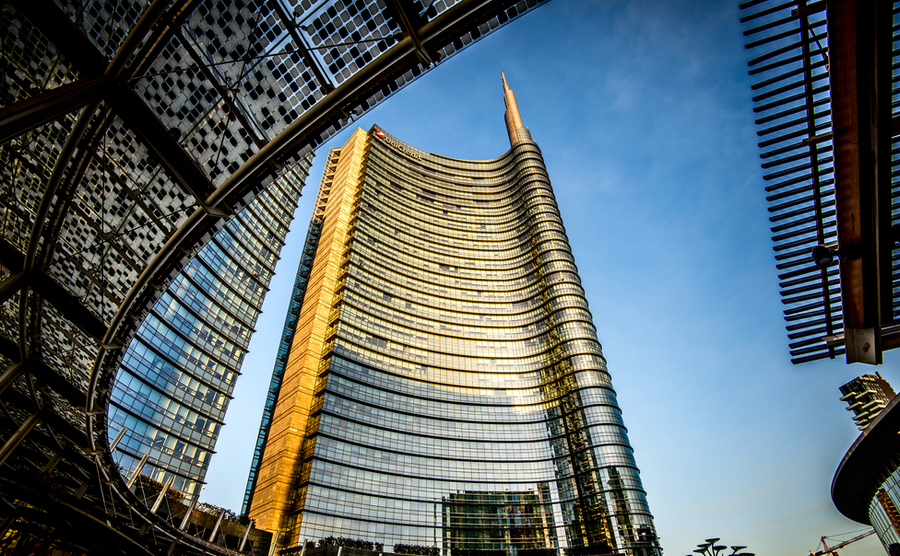
Milan’s banking district (UMB-O / Shutterstock.com)
Card payments in Italy
Whether you have a credit, a debit, or a charge card, you’ll find that they are all referred to as “credit cards” in Italy. The most common types are Mastercard, Visa, and the local option, CartaSì. The charges you’re subjected to will depend on each card, so make sure you confirm these before agreeing to the account. You can find credit cards with added extras, such as air miles, insurance, etc.
Tax planning before you move to Italy
Key tax considerations to take into account before the move are:
- How and when to notify HMRC that you are planning to leave the UK. This is essential for those moving permanently and could result in a nice little tax rebate.
- What are the tax implications of your move to Italy? This is particularly important if you are keeping a property in the UK that you plan to let out, or if you will continue to receive an income from the UK.
- Are there any benefits of continuing National Insurance Contributions when you move to Italy, and how will this affect your state pension from the UK?
- Assess your existing life assurance and savings policies in the UK to see if they are still suitable and will cover you in Italy.
- As it is not usually possible to continue to contribute to ISAs after you move abroad, you need to establish what you can and can’t do with any investments you have in the UK.
- Will it still be possible to make payments into your UK pension, and will you still be eligible for tax relief or accumulated pension rights? Your financial advisor can help you to establish this.
- How will you manage any large cash balances you hold in the UK? Should you transfer them or move them offshore? Your financial advisor can guide you on what best suits your needs and circumstances.
- Be clear on your residence status and what is required of you from the Statutory Residence Test in Italy. This is especially important if you are planning to spend an equal amount of time in both the UK and Italy.
- What is required of you in terms of tax returns in both Italy and the UK, and when will you need to submit them? Remember, there are now considerable fines levied for late submissions.
- Inheritance laws. Ensure your estate and your will are protected. If you plan to become a resident of Italy rather than the UK, planning for your inheritance effectively is even more important.
If you’ll be buying property in Italy, bear in mind that careful financial planning is vital to the success purchase. As any property purchase in Italy will have an impact on your worldwide estate, you need to make sure that your tax status is correct to avoid paying additional taxes unnecessarily.
Before purchasing your chosen property, inform the estate agent and Notary that you intend to become a resident in Italy. If you plan to make your Italian home your main residence you will only pay 2% stamp duty when you purchase the property, as opposed to 9% for a second home.
Once you are a registered resident you are usually exempt from council tax (IMU) on your main residence (except luxury homes) and only pay tax on any land that comes with the property. This could be less than €200 a year in some areas. A big difference from council tax bills in the UK. As a resident, you will also get a discounted rate on your electricity bill, so don’t forget to let them know it’s your main residence.
Waste collection tax (TARI) relates to the property size, number of occupants, and also the location. In general, taxes on countryside properties are less than in the cities. Northern cities and popular tourist areas are likely to charge more than in rural areas and villages.
It will often be sensible to consult an Independent Financial Advisor (IFA), who will be able to ensure all the financial elements of your move to Italy are dealt with correctly.
Types of tax in Italy
If you spend more than 183 days in Italy, you are considered resident in Italy for tax purposes. You will have your codice fiscale and will be required to pay a number of general taxes, including property taxes, VAT, Capital Gains Tax, and Inheritance Tax. If you spend fewer than 183 days in Italy, you can still be liable to pay Italian tax on income, Capital Gains, and Inheritance.
Your Italian tax return will need to be filed by July 31st.
Income tax
If you’re employed in Italy or are renting out a property, you will be liable to pay tax on your Italian income.
Local property tax
Whether you are a resident, or non-resident, if you own property that you use as a second home or rental property you will be obligated to pay Imposta Comunale sugli Immobili (ICI), which is similar to UK council tax. The rate that you have to pay will be determined by which region your property is located in, and is payable twice yearly, in July and November. In 2016, the Italian government abolished this council tax for anyone using the property as a primary residence.
Capital gains tax
Capital Gains Tax (CGT) is a tax on the profits made by an owner when assets (such as property) are sold for a price that is higher than the original purchase price. No capital gains will be charged on the sale of a primary residence, or if the property has been owned for more than five years. In order to be charged, the asset needs to be sold. In Italy, CGT is charged at 20%.
Inheritance tax and gift tax
If you have inherited an Italian property or have been given it as a gift and you use it as a second property or as a holiday home, you could be subject to a cadastral tax, and potentially a mortgage tax. If the Italian property is your primary residence, you will be instructed to pay a fixed rate of tax.
Tax relief
If you plan on renovating a property that you have just purchased, you could be entitled to a 24% tax relief. This will need to be approved by your local Italian tax office prior to the work starting.
We recommend speaking to an independent financial advisor about your tax liabilities to ensure that you cover your back and are paying everything you need to pay. They can also help ensure all tax matters in the UK are dealt with.
As of January 2021, Italy is also offering tax reductions for foreign workers. To be eligible, you must:
- be an employee, self-employed, or a business owner,
- become a tax resident of Italy,
- commit to remaining a tax resident of Italy for at least two years following,
- not be a tax resident of Italy in the two preceding years, and
- spend at least 50% of the year in Italy.
If you meet these requirements, you could be eligible for a 70% tax cut — this increases to 90% if you’re living in Abruzzo, Basilicata, Calabria, Campania, Molise, Puglia, Sardinia, or Sicily!
Tax breaks for pensions
Certain villages in Abruzzo, Basilicata, Calabria, Campania, Molise, Puglia, Sardinia, or Sicily are also offering a 7% flat tax rate if you retire there. This tax rate replies to any overseas income, including pensions, business, employment, or rental income, and will last for nine years. However, pensions paid for by a foreign government may not be covered, so it’s best to seek financial advice for your independent situation.
You may be eligible for this tax break if you:
- have been tax resident outside of Italy for at least five years prior to the tax year in which you will become an Italian tax resident,
- transfer your tax-residence to one of the defined regions in southern Italy, in a municipality (comune) with a population of fewer than 20,000 inhabitants, or a municipality with fewer than 3,000 inhabitants in a defined seismic area, or
- have previously been resident in a territory with which Italy has in place arrangements for administrative co-operation — for example, sharing tax information.
Obtaining your codice fiscale
When moving to Italy, it’s essential that you obtain a Fiscal Code Number (codice fiscal). This works much like your National Insurance Number in the UK, and is necessary for paying taxes, accessing healthcare, and more. You can obtain your codice fiscale from the Italian tax office.
Claiming your pension when living in Italy
When you retire to Italy you can still claim your UK state pension. You will need to tell the UK government offices that deal with your benefits, pension, and tax that you are moving or retiring abroad. If you plan to retire in Italy, you will need to contact the following organisations prior to departure, to supply them with your new information:
- The International Pension Centre (if you are already receiving a State Pension)
- HM Revenue & Customs’ National Insurance Contributions Office
- Your local Tax Office
Drawing a pension in Italy is a relatively simple process, and there are two main options for doing so:
1. Direct payment into Italian bank account
Once you have checked whether it’s possible with your choice of Italian bank, you can opt to have your pension paid directly into your Italian account. If you plan on splitting your time between the UK and Italy, you will need to decide which account you want the payment to be paid into: your Italian account or your UK account. Should you change your mind about retiring to Italy, you can request your state pension revert back to being paid into your UK account.
2. Paid into UK account and transferred to Italy
You can also opt to keep your pension payments coming into your UK account and then transfer them to Italy yourself. In this instance, you must remember that the amount of money you receive each month will depend on currency exchange rates. To avoid receiving varying amounts each month, speak to Smart Currency Exchange about setting up a Forward Contract. This helps you to lock in an exchange rate for up to a year, so you always know what rate you’ll be trading at and how much will be coming into your account. Smart Currency Exchange can also help you to set up automated regular payments.
UK state pension
If you’ve been paying into a state pension in the UK, you will receive a claim form from the UK Pension Service four months before you retire. It is your job to inform them that you are planning a move to Italy and to provide them with your new address.
Private pension
If you have a private pension, you will need to consult your pension provider about your best options. They should be able to move the payment to an Italian account very easily, but as mentioned above, you will have to remember to consider how currency exchange rates will affect this payment.
Tax on your pension
Whether or not you are taxed on your UK state pension will depend on the following factors:
- Whether you are declared as “non-resident” in regard to tax purposes
- Which country you are deemed tax resident in
If you reside in Italy permanently, you will be classed as a non-UK resident and you will pay tax on your pension in Italy. If you alternate between the UK and Italy, you’re likely to remain UK resident for tax purposes, and you’ll be subject to UK pension tax.
In order to determine how best to proceed in your exact circumstances, we recommend you speak to an independent financial advisor. They will be able to help you determine the best method of receiving your payments to ensure you get the most from your money.
Maximising your pension in Italy
If your plan is to move to Italy permanently, you could benefit significantly from moving your pension into a Self-invested Personal Pension (SIPP), or a Qualifying Recognised Overseas Pension Scheme (QROPS). Conditions do apply to these schemes, but in the right circumstances these types of plans can reduce your tax bill and provide you greater control over your pension.
Self-Invested Personal Pension (SIPP)
This is a UK government-approved personal pension scheme that gives the investor more power to make their own decisions on a range of investments, including:
- Overseas property
- Stocks and shares on a recognised exchange
- Futures and options traded on recognised future exchanges
- Authorised UK unit trusts
- Unlisted shares
- Investment trusts, subject to Financial Conduct Authority (FCA) regulation
- Commercial property
- Ground rents
- Residential property
- Gold bullion
- Tangible moveable property with a market value of less than £6,000
- Exotic assets like vintage cars, wine, stamps, and art
Do note that some of these may be subject to tax charges.
There are four different types of SIPP:
- Deferred: A Personal Pension Plan where most/all assets are held in insured pension funds. Self-investment withdrawal is delayed/deferred until a later date.
- Hybrid: Some assets must be held in conventional insured pension funds, but the rest can be ‘self-invested’.
- Pure/Full: Offers unrestricted access to many acceptable investment asset classes.
- SIPP Lite/Single Investment: This is a much more recent trend and involves placing all funds in one main asset with much lower fees.
Qualifying Recognised Overseas Pension Scheme (QROPS)
This is an overseas pension scheme that meets criteria outlined by HMRC. The scheme allows you to transfer your UK pension into it, without paying additional charges or incurring any unauthorised payments.
As well as offering investment and currency flexibility, a QROPS proves popular with British expats because of the tax advantages it presents. Taxation is reduced, UK taxation can be avoided as long as you remain a tax resident outside the UK, and a QROPS can be transferred to an appointed beneficiary in the event of the scheme holder’s death.
A number of changes were made to this scheme in 2015, which affected the qualifying criteria and the countries involved. Although these shouldn’t have an effect on those transferring pensions for living in Italy, we still recommend chatting to a tax adviser about QROPS and what you need to do to qualify.
It’s worth noting that UK authorities will only allow you to transfer a pension abroad if the scheme meets their outlined criteria: you need to be living abroad or going to live abroad, and you must remain there.
It will take close to 10 years of being a non-resident and having moved your pension to a QROPS for real benefits to be realised. This is why it’s important to consider your options now, so that you can get an early start on making your pension work for you. We can put you in touch with our advised authorised tax and financial advisory firm, who’ll be able to advise on what route best suits you and your circumstances.
Italy visa requirements
If you’re wondering whether you need a visa to visit Italy after Brexit, don’t worry — travel rules are the same as they were in 2020, so you still don’t need a visa if you’ll be in Italy for less than 90 days. If you intend to stay longer than 90 days, or if you plan to work while you are there, you may need to apply for a long-stay/D-visa.
Post-Brexit, the Italy visa and residency process for UK expats is largely the same as for other non-EU nations — possible, but tricky to navigate if you are unfamiliar with the system. You will need to consider which visas and permits best suit your needs.
The Italian Ministry of Foreign Affairs (MAECI, or Farnesina) has a handy calculator on their website that you can use to find out what permits you need, according to your nationality, country of residence, the reason for your stay, and the duration of your visit. Once you own property in Italy, don’t forget to check the requirements for any visitors you may receive too.
You may notice that you’ll need to pay a fee to apply for a visa. This is for the administrative costs of processing the visa application. Fees for a long-stay visa for Italy are currently £105.20, plus a £13.16 VFS Global service fee. Applications can be made up to six months before your travel dates. They also state that it can take up to 90 days for a national visa to be processed.
Once you’ve been granted a long-stay visa, you will then need to apply for a residence permit. This is because the visa allows you to enter the country upon arrival, while the residence permit enables you to live in Italy for the duration of your stay.
Italy Schengen visa
A Schengen visa allows people visa-free movement between the 26 Schengen countries, all of which are in the continent of Europe, for a period of 90 days. Italy is one of the 26 countries who have signed the agreement, but the UK is not part of this zone. However, British citizens can gain unrestricted movement within Europe for 90 days at a time, even post-Brexit, thanks to the Schengen visa waiver. If you are a UK citizen, you don’t need a Schengen visa to visit Italy or any of the other 25 countries for less than 90 days.
Broadly speaking, it is travellers from Africa, India, and China who need to consider applying for a Schengen visa. That being said, the Schengen visa only applies if you’re intending to holiday in Italy or if you’ll be heading over for a property viewing. Our article on 90-day holiday visas can tell you more. If you’ll be staying in Italy for longer than 90 days in any 180-day period, for example if you’re moving there or staying there long-term, then you will need to apply for a visa.
Italy investor visa
If you’re planning to invest in the economy once you move to Italy, then you may be eligible for an investor visa. You can apply for this visa if you invest €500,000 to €2 million in an Italian company. This is lowered to €250,000 if you’ll be investing in a start-up. While this is similar to the Golden Visa available in countries such as Spain, Portugal, and Greece, Italy’s investor visa doesn’t yet list real estate as a qualifying factor.
To qualify for an investor visa, you’ll need to gain a Nulla Osta, which is a certificate of no impediment from the Italian Government. To get this you’ll need:
- your passport,
- a CV showing your academic and professional experience and qualifications,
- documents proving that you have the financial resources to invest (such as bank statements) — you should be able to prove that these funds are transferable with a letter from your bank,
- a description of the nature of your investment and your past experience as an investor,
- a signed Declaration of Commitment to using the funds, and
- a clean criminal record.
Once you’ve received your Nulla Osta, you’ll need to take this to your nearest Italian Embassy or Consulate, along with:
- your passport,
- proof of accommodation in Italy,
- proof of residence in the UK,
- proof of income, and
- a passport-size picture of yourself.
Once you’ve been granted an investor visa, it will be valid for two years. During this time, you will be able to request a residence permit. This permit is also valid for two years and you can choose to renew it for a further three years after this time.
Italy elective residency visa
The elective residency visa is intended for people moving to Italy who have financial independence that does not rely on employment. The source of your regular income cannot be paid employment, but can include property rental income, pensions, investment funds, royalties, shareholdings in a company etc. As a result, it’s the most popular option among retirees who are receiving a pension.
To be eligible for the elective residency visa, you must be able to provide:
- proof of UK residence,
- a passport-size photograph on a white backgroud (learn more about Schengen photo requirements)
- a valid passport whose expiry date is three months longer than that of the visa requested and has two free pages that are blank on both sides,
- documented financial resources to prove that you can support yourself financially without working (usually around €31,000 if you’re living alone and €38,000 if you’re a married couple, plus an extra 20% for each dependent),
- documents relating to accommodation in Italy to be chosen as residence, owned, or rented, with a registered lease or deed,
- a letter explaining your reason for moving to Italy,
- a one-way travel reservation,
- marriage/birth certificates if applying with dependent spouse or children, and
- proof of health insurance.
Once you’ve been granted an elective residence visa, it will be valid for two years. After this time, you can choose to renew it further. Once you’ve lived in Italy under this visa for five years, you can then apply for permanent residency.
Italy family visa
If a member of your family (such as your spouse, child, or dependent parent) is an Italian citizen or a non-EU citizen with an Italian permit of stay, then you’ll be eligible for an Italian family visa. To obtain this visa, you’ll need to provide proof of relationship to the person, such as through a birth or marriage certificate. If you’ll be joining your child in Italy, then they must be unmarried and under the age of 18, or dependent on yourself.
Italy student visa
If you are a non-EU student looking to move to Italy for the purpose of studying, then you will need to obtain a student visa. There are two options depending on your length of stay:
- Type C — short-stay visa or travel visa intended for a period of no more than 90 days, or
- Type D — long-stay visa intended for a period of more than 90 days
When applying for a student visa, you should provide a letter of acceptance from the Italian institute you’ll be studying at, proof of accommodation, sufficient financial means, and health insurance.
Italy work visa
If you’re an EU citizen, then you do not need a visa to work in Italy. But, as the UK is no longer part of the EU, you will need a work permit to work in Italy if you are moving from the UK. Italy gives out work permits on a quota-based system which states the number of non-EEA workers, including those from the UK, that are permitted to work for Italian companies. There are also exemptions to these quotas for certain categories of workers, so it’s worth speaking to a trusted visa specialist to see if a work visa is an option for you.
You must have a job and be able to provide a signed employment contract before you apply for an Italian work visa. The good news is that your employer will do most of the application for you. They will apply for a work permit and, once granted, you’ll have six months to apply for a work visa with your nearest Italian consulate or embassy.
How long your work permit lasts will depend on your individual employment and quota limits.
Self-employment visa
If you’ll be starting your own business or working freelance once you’ve moved to Italy, you may be able to obtain a self-employment visa. Before you apply for the visa, you will need to get a Nulla Osta from your local Immigration Desk, as well as get the necessary authorization and documentation to grant you permission to perform your specific self-employed activity in Italy.
Once you have these, you can apply for the self-employment visa at the Italian consulate or embassy in the UK. With your self-employment visa, you can then apply for a residence permit to live and work in Italy.
Working holiday visa
Italy currently has agreements with Australia, Canada, New Zealand, and South Korea to allow people between the ages of 18 and 30 to undertake a working holiday programme. At the moment the UK has no such agreement.
Digital nomad visa
At the beginning of 2022, the Italian Government announced that they will be implementing a new digital nomad visa which will allow company-employed and self-employed people to work from home in Italy. This new visa has been created in response to the COVID-19 pandemic and the rise in remote working, and it will allow non-EU citizens to move to Italy and work online with a foreign company — so, in theory, you could still work for your UK-based employer after you relocate to Italy.
At the time of writing, the government are still ironing out the creases in the legislation, but you can read everything we know so far in our news article on the digital nomad visa.
Where to apply for a visa
According to Farnesina, if you currently live in England, Wales, or its islands, you need to apply for a visa with the Consulate general of Italy in London. If you live in Scotland or Northern Ireland, you can apply at the Consulate general of Italy in Edinburgh.
Italian residency requirements
Before 2021, there was no legal requirement for UK residents to have a residency permit to live in Italy. However, since the UK has withdrawn from the EU, that’s no longer true. So, you will have to acquire residency if you intend to spend more than 50% of the year in your new home.
Like people from non-EU countries such as the US, Australia, and New Zealand, UK residents will first have to apply for temporary residency, and you can then apply for full residency after living in Italy continuously for five years.
Whatever your nationality, according to Italian tax code, you are a resident in Italy if:
- you have a permanent home or principal place to stay in in Italy, where you spend most of your time,
- you spend more than 183 days (half a year) in Italy during the year, or more time in Italy than any other country,
- you are employed, or carry out an occupation, in Italy, or
- your centre of economic interest is Italy.
If you’re moving to Italy with children, don’t worry if they don’t have their residency through yet. According to Presidential Decree, non-Italian children, regardless of being resident or not, are entitled to free education. Italian schools have to accept them, and registration can take place even if the school year has already started.
How to get residence in Italy
If wish to stay in Italy for over three months, then you must register with the Anagrafe (Registery Office) of the municipality of residence.
You can get an application kit from the post office. It consists of an envelope (with a yellow stripe for non-EU nationals and a blue stripe for EU nationals) and contains two forms and a list of instructions. It’s worth taking photocopies for yourself as a backup.
However, the cheapest and easiest way to get your residency is to go in person to the Patronati office at your local comune, taking with you all the documents needed to accompany the application.
You will need the following:
- Your passport
- Four passport sized photos
- Your Codice Fiscale This number is issued by the Agenzia delle Entrate (the Italian Revenue Agency) of the Ministry of Economy and Finance of Italy. You can find your local revenue office here. You will need to fill in a form and show your passport.
- If you aren’t working you will need to provide proof that you have sufficient funds to support you, such as a bank statement. They consider sufficient funds to be the Italian minimum annual social security allowance at that time. If you have an income you must show proof of that.
- A private health insurance policy which is valid for at least one year
- If you have bought a property to live in, take your deeds along. You will be registering that you are changing address to this property. They’ll look at the size of the property to calculate what to charge you for TARI. This is the Italian tax that covers the cost of collecting and disposing of local waste.
- The office staff will help with filling in the relevant forms and photocopying documents. You will be asked to pay for a revenue stamp (about €14.62) and charged an administration fee. The amount will vary from place to place, as will the time it takes for them to issue you with your residency permit.
- Non-EU family members of EU citizens will also need to show an EC Long-Term Residence Permit (carta di soggiorno).
The council will then check that you are really living in the property. A policeman will be sent round unannounced to check you are there. This could be at any time of day. Their visit is usually quite brief, and they’ll often only come in for around five minutes, have a chat, and ask you to sign a form.
You may then be able to collect your Carta d’identità at the office you made the application at. Some offices will choose to send it by registered post. The card should be one of the new Carta d’Identità Elettronica. This is credit-card sized, but not all areas have the means to issue them yet so you may get a paper style one. If you’ve ever noticed Italians going through customs, they use this within the EU instead of a passport.
How to get a long-term residence permit
If you’re coming from outside the EU, for instance from the UK, you must apply for an Italian Residence Permit (Permesso di Soggiorno) within eight days of travelling to Italy. The process for applying for a temporary Italian residence permit is as follows:
- You must submit your application to an authorised post office (Sportello Amico), using the relevant kit available in the post office.
- There are authorized institutions and municipal offices that will provide you with information and assistance free of charge. When the form is sent, the post office will issue a receipt bearing two personal identification codes (user ID and password) which you can use to follow the state of the application on the Immigration Portal.
- You will be given an appointment to go to the Police Head Quarters (Questura). You should take all the originals of your documents and be prepared to have your fingerprints taken.
- The Questura will notify you when your Residence Permit card will be issued.
You will then be given a temporary residence permit lasting six months, or one or two years. You will be able to renew it at least 90 days before it expires (30 days for a six-month permit).
All foreign nationals not belonging to the European Union in possession of a valid residence permit are obliged to request registration in the municipality where they intend to establish their residence. Visit the Council Offices (Comune) in your nearest town for guidance.
After living in Italy for five years under temporary residency, you’ll then be able to apply for a permanent residence permit.
What are the benefits if you get a residence permit for Italy?
While it is a legal requirement, there are many benefits to obtaining a residence permit for Italy:
- You pay less purchase tax when you buy your home. In fact, you pay less as long as you agree that you will be applying for residency within 18 months. On a second home or luxury property you would be paying 9%. On your main residence you pay just 2% of the cadastral value of the property.
- You only pay council tax (IMU/Tasi) on your primary residence if it is classed as luxury. Think how much that is going to save you compared to council tax in the UK!
- You can enrol in the health serviceand benefit from the same healthcare as Italian citizens. When you register you receive a document called the Tesserino sanitario personale(Italian Health Insurance Card). Many public healthcare services are then free, or you pay a reduced fee — for example, when you are referred to a specialist.
- The electric provider (Enel) will charge you a reduced rate.
The Identity card (Carta d’identità) is very useful. You can show it instead of your passport when you are out and about in Italy. Indeed, when you do need to establish your identity, Italians will breathe a sigh of relief when you produce a Carta d’identità and codice fiscale!
The new biometric residence card
The Italian government has introduced a new biometric residence card only for UK nationals that were living in Italy before 1st January 2021. This is called a “Carta di Soggiorno” and should not be confused with the “Permesso di soggiorno” that you will be applying for. The local immigration office at the police headquarters (Questura) deal with the applications for the carta di soggiorno.
Dual residency UK and Italy
In some cases, you may be able to acquire dual residency in the UK and Italy. This is the case if your parents are Italian nationals, if you have ancestry in Italy, or if you marry an Italian citizen.
To gain dual residency, you’ll need to gather documents proving your ties to Italy, such as a marriage certificate, birth certificates, or ancestry documents. You may need to hire a translator to translate this information, and you’ll most likely need to have your files apostilled. You’ll then need to take these documents, along with a Declaration of Applicant Form, to your local Italian consulate. If your application is approved, you can then apply for an Italian passport.
A note on I.D. and documentation
Italian residents, including British expats, are legally obliged to carry photographic identification around with them at all times. So, it’s best to get into the habit of doing so before you move to Italy. The majority of people opt to carry their residency card. If you can drive, you will need to have this, along with your license, registration, and proof of insurance, inside your vehicle.
Once you have become resident in Italy, you should exchange your UK driving licence for an Italian one. Previously this was just a simple exchange, but post-Brexit you might be asked to take an Italian driving test — in Italian! To check the rules or convert your UK licence, visit your nearest Ufficio Provinciale della Motorizzazione Civile or Automobile Club Italiano.
The Italian healthcare system
Italy’s National Health Service, which is called the Servizio Sanitario Nazionale (SSN), is financed from income tax and Government supplements — known as a single-payer healthcare system. This makes the health service free or low cost to the public. If you’re employed or self-employed and are a resident in Italy, you can access the SSN for free as you will be paying into the Italian social security system. Any dependents can also be registered. If you are not working, you can still access public healthcare voluntarily by paying an annual fee — this is known as fee each year ‘iscrizione volontaria’.
Whether you are a UK, EU, or non-EU citizen, once you have become a resident in Italy and have registered with the SSN, you will receive a Personal Healthcare Card (Tessera Sanitaria) and have access to Italian healthcare. This means that you are entitled to receive the same universal healthcare and treatment as Italian citizens.
If you choose not to register with the Italian healthcare system, then you will need to take out private health insurance.
It’s good to bear in mind that, although there is standard practice for healthcare in Italy, you may find your local authority has a different interpretation of the complicated guidelines they are given. Some expats have found that this situation, more often than not, has worked in their favour, as healthcare providers are more concerned with helping someone who is sick or injured than filling in forms and taking your money.
Will I still have access to the NHS?
Unfortunately, if you have moved to Italy, then you won’t automatically retain your right to NHS services. This is because the NHS is a resident-based system, so you need to be ordinarily resident to access its services. There are some small exceptions to this, such as if you are a student.
So, if you do plan to return to the UK temporarily, make sure to take out travel insurance. If you need primary care, for example, to visit A&E or the GP, you won’t be charged, but for anything beyond this, it wouldn’t be covered.
If you live in Italy, you may be entitled to an Italian EHIC to use when you return to the UK. This card allows you to receive medical assistance during a temporary stay in the countries of the European Union, Iceland, Liechtenstein, Norway, or Switzerland. It will cover you for medical needs above just primary care in the UK.
If you decide to move back permanently, you will regain your rights to the full NHS.
Do I need health insurance to visit Italy?
Your EHIC (or GHIC) will provide you access to Italian healthcare when you travel to Italy in a temporary basis, such as when you’re viewing property, so you do not necessarily need health insurance if you carry one of these cards.
However, an EHIC or GHIC is not an alternative to travel insurance. It won’t cover private medical healthcare or costs, such as mountain rescue in ski resorts, being flown back to the UK, or lost or stolen property. The EHIC does however cover all treatment that is needed to enable you to continue your stay, including pre-existing medical conditions and routine maternity care.
Even if you don’t have an EHIC, you will be treated in an emergency and any charges will be billed to you afterwards. However, it is recommended to purchase travel insurance to make sure you are covered.
If you require a visa, for example if you intend to stay in Italy for more than 90 days or are from outside Europe, then you will have to arrange travel insurance anyway as part of your visa application.
Getting an Italian health card (Tessera Sanitaria)
Once you receive your Identity card (carta d’identità), which proves you are resident in Italy, you can register with the local health authority (Azienda Sanità Locale A.S.L). They will also ask to see your passport, your Codice Fiscale (tax identification number), self-certification of your place of residence, as well as the important carta d’identità or permesso di soggiorno.
You will be assigned a GP or given a list of doctors to choose from, and a paediatrician for children. Your Tessera Sanitaria card will then be posted to you when it’s ready. To cover you until it arrives, make sure they print you a paper version of the card. The Tessara Sanitaria card itself is the same size as a bank card and on the back is the tax code, barcodes, a magnetic strip, and the words Tessera europea di assicurazione malattia (TEAM). This means “European health insurance card”, allowing you to use it in other EU countries too.
If your application is considered mandatory, for example if you are employed/self-employed or have been resident in Italy for over five years, the card is free. However, there can be some confusion on a local level, so it’s best not to ask questions and just apply and see! At worst you may have to pay for health insurance for the first five years of residency or apply for voluntary registration which can cost approximately €387 a year.
If you are self-employed, your first step is to register with the National Institute of Social Security, or Istituto Nazionale di Previdenza Sociale (INPS). Whether self-employed or employed in Italy, as soon as contributions are paid into the Italian National Insurance system, you’ll be able to get your Tessera Sanitaria.
Private health Insurance (assicurazione sulla salute)
Rather than going through the SSN for your healthcare in Italy, you may choose to take out private health Insurance. If you need in-patient care, it might allow you to get a private appointment quicker. In some parts of the country, particularly in the North and around cities, there are some excellent private hospitals. These are among the finest in the world, with short waiting times, impressive facilities, and world-renowned doctors.
Treatments vary in cost, but they are regulated by the Ministry of Health. Some of the big international insurance companies you see advertised quote high prices. If you’re only paying for cover to show the local authorities as part of your application for residency, you can just go to a local Insurance agent and ask for the cheapest cover that would be accepted with your residency application. For the most basic cover, it could cost you around €150 for the year.
Whatever level of cover you want, it is worth shopping around both online and locally and asking other local expats for recommendations.
Is dental care free in Italy?
By and large, dental care operates on a private basis in Italy which means that non-emergency dental care is not free. The standard is very high. If you wish to receive the dental care offered under the healthcare system, you will need to visit SSN operated public hospitals, or locate a dentist close to you that is managed by the Local Healthcare Authority.
Children’s vaccinations
If you are a resident of Italy, you need to make sure any children you have living with you are vaccinated. The 2017 Lorenzin decree, named after former Health Minister Beatrice Lorenzin, made 10 vaccines mandatory for children between 0 and 16. It is mandated that any children living in Italy between 0 and 6 be excluded from day care and kindergartens if their parents don’t provide proof that they were vaccinated, and there are fines for parents of children between 6 and 16 years old who aren’t vaccinated. However, this may change in the future.
Where to access healthcare in Italy
It is very easy to receive healthcare and treatment in Italy, partly because there are many different ways to access it. If you’d like to know what healthcare is like in more detail, you can read a first-hand account of Julia’s experience with the Italian healthcare system.
At the pharmacy (Farmacia)
Almost all towns in Italy have a 24-hour pharmacy, offering a wide range of medication. For minor health problems, even if you’re just visiting, simply look out for the illuminated green cross. Pharmacists are well qualified to give help and advice, and they even sell some items over the counter which would require a prescription in the UK. This can prove useful when an inhaler has run out, or if you need some antibiotics for an infection. Both of these medications are cheaper over the counter here than a UK prescription charge.
The pharmacy earns its money on less urgent products such as paracetamol, cough mixture, and vitamins, which can be quite expensive for non-residents compared to in the UK. You can’t buy medicines in supermarkets in Italy, so it’s worth stocking up your medicine box on trips back to the UK. Once you have your Italian health card, you can show it at the pharmacy to get a discount, and prescriptions from the doctor are either free or at a subsidised rate.
At the Doctors (Medici di Famiglia)
According to data from the OECD, Italy has a very high proportion of doctors for its population. You are likely to find quite a few doctors dotted all around the towns. Often it will be just a door in the middle of a normal residential street with a glass cabinet on the wall displaying the surgery times.
Most days you can just turn up and wait your turn, but there are also some appointment-only days. They often don’t have a receptionist, so you just take a seat and ask who was last in before you. If someone comes in looking particularly ill, no one minds them jumping the queue. People will also pop in to check the tray for their prescriptions.
General practitioners or family doctors are listed in yellow pages under Medici Generici. Specialists are under Specialisti and their speciality, e.g. Ostetrica e Ginecologia (obstetricians and gynaecologists). Note that the word dottore is a courtesy title used to address any university graduate.
Most Italian doctors don’t speak English. Medical words probably weren’t on your Learn Italian course either. But most will have computers with Google Translate, so by using that, or DeepL, and hand gestures, you can have a constructive and possibly rather amusing consultation. You may find it helpful to go prepared with your list of symptoms already translated and printed out. You have a better chance of finding an English-speaking doctor in the major cities, such as Milan, Rome, and Florence. The Gov.UK website lists some English-speaking doctors as does the US Embassy website.
If the doctor wants to refer you to a specialist or to have a test at the hospital, they print out a small form which you take to the hospital reception/ticket office to make an appointment. All your medical documents are kept by you.
At the Hospital (Ospedali)
An A&E department of a small-town hospital usually works in the same way as the doctor’s surgery. You just wait your turn and more urgent cases get priority. Hospitals in major cities tend to have more facilities and specialist departments, so for certain emergencies patients may choose to go directly to a city hospital.
If you have been sent to the hospital by your doctor to make an appointment with a specialist or for tests, you must go to the ticket office first. They will make all your appointments for you on the spot, for whichever department it is, checking dates and times with you and even booking them for another nearby hospital if there is an earlier date available or if they have a specialist department. Then you will be given a print-out of your appointment details.
There are some services that you are required to pay a set “ticket” price for, such as an ultrasound scan, but it is usually very reasonable. Each local authority is responsible for its own finances and so the “ticket” price will vary from place to place.
Through the emergency services
Italy’s emergency care is second to none. If you need an ambulance, call 118 or the general emergency number which is 112. If you are able to make your own way to the hospital, head to the emergency department (pronto soccorso). Should you need urgent medical treatment and are unable to get to hospital, you can also call the local duty doctor service (guardia medica). Numbers can be found in the local telephone directory for where you live. You can read a first-hand account of Italian emergency care here.
Moving your belongings to Italy
As soon as you’ve decided that you are going to move to Italy on a permanent basis, you will need to start considering how to transport all of your possessions to your new home.
Deciding what to take
Before you can start getting quotes, you will need to establish exactly what you want to take with you, and what you will leave behind, sell, or give to charity. Now is the time to work out what you use and what you don’t.
If you’re happy to refurnish your new home entirely once in Italy, you won’t have to worry about removals at all. If you’re planning to buy furniture once you arrive, it’s probably best to make sure you’re confident of finding the items you like, at a price you’re happy with. After all, it could be cheaper to transport your current furniture, rather than to buy everything new.
When it comes to white and electronic goods, bear in mind that most household items in Italy, kettles, hoovers, microwaves etc, require additional safety plugs. This can make things tricky when you already have to have one adapter plug to get your British items to work. Factor this in when deciding whether to transport goods or buy new. Items like lamps, laptops, phone chargers and so on, don’t require these safety adapters, so they will work just fine with a standard adapter.
When considering whether or not to take your electricals, consider how much you could get for them if you were to sell them, and how long they are likely to last if you do decide to take them with you. If you will need replacements in a year or two, it might make sense to purchase in Italy. Also, if they require repairing after you’re in your house and all set up, it might prove difficult to find appliance engineers who know how to fix your British items.
Transporting your belongings
Unless you plan on hiring a van, packing up your belongings and driving down to Italy yourself, you will need to employ the services of a moving company. Seek recommendations from friends that have previously moved countries, and make sure that anyone you request a quote from is registered with the British Association of Removals (BAR). We recommend seeking at least three quotes to ensure you secure a competitive rate. Be sure to check the coverage of the insurance they offer, and whether the quote includes the cost of the workers packing and unpacking your belongings at either end.
As the UK is no longer part of the EU, your belongings will need to clear customs on arrival. It’s important that you have all the relevant customs documents prepared before you move to Italy. Your removals company or courier will be able to advise you on the forms that are relevant to your circumstances.
Tips on how to pack
- Make sure that all boxes are labelled clearly with what is inside the box and which room they came from. This will make unpacking at the other end far easier.
- Once your belongings are loaded up, you won’t be able to access them, so ensure you keep all essential items aside, so you don’t risk packing them up and not seeing them again for a month or two.
- Make sure that keys for your office, car, and accommodation are kept aside, labelled, and are ready to hand over to the right people when you leave.
- There will be a number of regulations you need to comply with when your possessions enter a new country. Your removals company will be able to supply you with a specific list of what can and cannot enter Italy.
- Be sure to drain all oil and petrol out of lawnmowers or similar equipment prior to transportation to ensure they comply with fire regulations, and to avoid the risk of a leak damaging your other possessions.
- Remove all batteries from items such as remote controls, torches, and radios, as they can leak in transit and cause damage too.
- Clean any garden furniture, tools, and sports equipment, and even paint the furniture if necessary. Items covered in dirt can be denied at customs or can severely delay delivery of your items whilst they’re stuck in quarantine.
Storage
If you aren’t moving straight into your property, you may need to consider storing your belongings in the interim. You could find it is cheaper to store them in Italy than it is in the UK, so it is worth researching both options.
To be put in touch with our trusted removals company, call the Resource Centre today on 020 7898 0549
Relocating to Italy with pets
If you’re one of the many expats who wouldn’t dream of making the move to Italy without their beloved pets, you’ll be delighted to hear that transporting them is a relatively simple process. As long as you take the right steps, moving countries with your puppy in tow should go ahead without a hitch.
Preparing your pet for travel
In order to move to Italy, your vet will need to provide you with certain documents. For each pet you are transporting you will need an animal health certificate that confirms the following:
- Identification by microchip
- Valid rabies vaccine (inactive)
- New vaccination pass (blue pet pass)
- Blood test to confirm the vaccine is in the system
The certificate issued will only be valid for four months, so make sure you time it right. No animal without a certificate will be allowed into Italy.
If you’re moving from the UK, you will need to sign up to The Pets Travel Scheme, which allows your pet to travel freely to and from the UK without them having to be quarantined every time. For more information on this, visit the website for the Department for Environment, Food and Rural Affairs (DEFRA). It is worth noting that you are limited to bringing up to five animals into the country, and that all of them must be older than three months.
Transporting your pets to Italy
If you are planning to drive to Italy, transporting your pets will be a relatively simple process. Animals are allowed on all ferries, for an additional cost of course. It is worth bearing in mind that your animal will have to stay in the car for the duration of crossing, and sadly, you won’t be allowed to stay with them. This makes it vitally important that you consider the likely temperature at the time of year you are going to travel. You’ll need to remember to leave windows open and to supply a lot of water, and always ask the staff on the car deck to keep an eye on your pets — they are usually more than happy to help with this.
If you plan on flying to Italy, you should bear in mind that most low-cost airlines don’t transport pets. Fortunately, most major airlines do. Cats and small dogs are sometimes allowed to fly with you, as long as they remain in their carriers for the duration. Larger animals will have to be placed in the hold inside their travel cages. This is the usual method of transporting pets, but if your animal is particularly nervous or elderly, you may be better off driving.
Once you’ve arrived
Italians love pets — particularly dogs — so you can expect them to be well received wherever you’re headed for in Italy.
As soon as you arrive, purchase an anti-Leishmaniasis collar for your dogs. This is a disease that’s carried by sand flies and mosquitos, and can be fatal when contracted by dogs. Spring and summer are the most dangerous times. It is recommended that your pets undergo a blood test every January to check they are clear of the disease. If they’re discovered to have it, they can then be treated before it progresses too far.
We advise you to seek pet insurance to cover your furry friends in the event of illness. There are many insurance companies offering competitive policies across Italy, and there are also some insurance providers in the UK that offer overseas cover.
There’s a lot to plan when moving to Italy from the UK, especially post-Brexit. But, as long as you follow the advice above, you can’t go far wrong. Here at Italy Property Guides, we’re well versed in everything to do with relocating to Italy, including buying property, and we’re always on top of the latest property news so you can be confident that you’re only getting the most up to date advice. Be sure to take a look at the rest of our guides too, to help you make the most of your new life in Italy.
Explore our range of free Italy property guides
Make your dream move — download our free expert guides
Healthcare Abroad – Taking care of your health doesn't stop when moving to Italy. Get this one stop shop for expatriate healthcare.
After Brexit Guide – To help you plot your way through a possible post-Brexit scenario, to ensure you can fulfil that dream of an Italian lifestyle.
Your Negotiation Guide – A handy guide to everything you need to know about negotiating for a property in Italy.
A Property Buyer's Guide to Currency – A currency specialist’s ‘insider’s guide’ to a successful property purchase, written by the experts.
Speak to an expert
Our guide should give you a detailed overview of the property buying process in Italy, but you’ve still probably got a few things you’d like to ask. Get in touch with our Italian property experts on +44 (0)20 7898 0549 from Monday–Friday, 8:30am–6:00pm or email [email protected].
The team will be able to assist you with a wide range of things to do with your move, like talking you through the next stage of the buying process or how to plan a productive viewing trip.
They can also help you connect with our network of trusted professionals, including estate agents, currency specialists, solicitors, financial advisers, and property surveyors. Contact us via the details above or fill in an enquiry form below to get started.
Download your free copy of the Italy Buying Guide

The Italy Buying Guide covers every stage of the property buying process in Italy, sharing our experience and knowledge to ensure a safe and successful property purchase. The guide will help you to:



